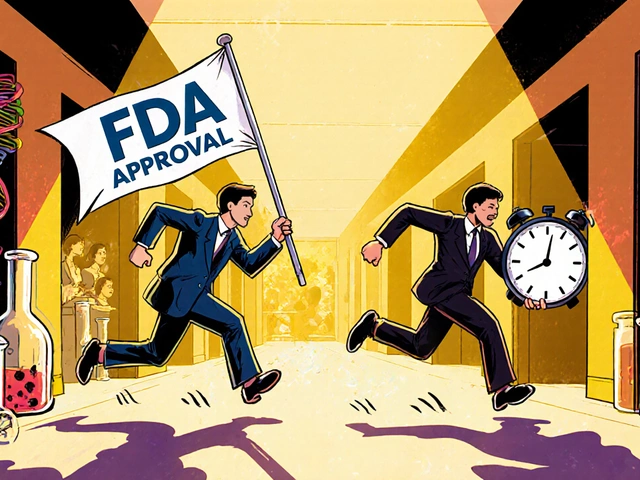Introduction: Understanding Oxybutynin
Oxybutynin is a medication that is commonly prescribed to individuals who suffer from an overactive bladder or urinary incontinence. It helps alleviate the symptoms of these conditions by relaxing the muscles of the bladder, which allows the bladder to hold more urine and reduces the frequency of urination. In this article, we'll explore how long it takes for oxybutynin to start working and discuss various factors that may impact its effectiveness. We'll also cover potential side effects, as well as tips for managing urinary incontinence and overactive bladder.
The Science Behind Oxybutynin's Mechanism of Action
Oxybutynin belongs to a class of medications called anticholinergics, which work by blocking the action of acetylcholine, a neurotransmitter responsible for stimulating muscle contractions. By inhibiting acetylcholine, oxybutynin helps to relax the smooth muscles of the bladder, allowing it to hold a larger volume of urine and reducing the urge to urinate. This, in turn, can help alleviate the symptoms associated with an overactive bladder and urinary incontinence.
Factors That May Impact Oxybutynin's Onset of Action
There are several factors that can influence how quickly oxybutynin begins to work for each individual. These factors can include the severity of the condition being treated, the dosage of the medication, and the form of oxybutynin being used (e.g., oral tablet, extended-release tablet, or topical patch). Individual factors, such as age, weight, and overall health, can also play a role in how quickly the medication takes effect.
General Timeline for Oxybutynin to Start Working
While the amount of time it takes for oxybutynin to start working can vary depending on the factors mentioned above, most people will begin to notice an improvement in their symptoms within a few hours of taking the medication. For some individuals, it may take up to a week for the full benefits of oxybutynin to be experienced. It is essential to follow the prescribed dosing regimen and to communicate with your healthcare provider if you are not experiencing any improvement in symptoms after a week of taking the medication.
Oxybutynin Dosage and Administration
Oxybutynin is available in several different forms, including immediate-release oral tablets, extended-release oral tablets, and topical patches. The dosage and administration of the medication will depend on the form being used and the severity of the condition being treated. Your healthcare provider will determine the appropriate dosage and form of oxybutynin for your specific needs, and it is important to follow their instructions carefully to ensure optimal results.
Potential Side Effects of Oxybutynin
As with any medication, there are potential side effects associated with the use of oxybutynin. Some of the most common side effects include dry mouth, constipation, dizziness, and blurred vision. These side effects are generally mild and may improve as your body adjusts to the medication. However, if you experience any severe or persistent side effects, it is important to contact your healthcare provider for guidance.
Tips for Managing Overactive Bladder and Urinary Incontinence
In addition to taking oxybutynin, there are several lifestyle changes and strategies that can help manage the symptoms of overactive bladder and urinary incontinence. These can include:
- Performing pelvic floor exercises, such as Kegel exercises, to strengthen the muscles that control urination.
- Limiting the consumption of bladder irritants, such as caffeine, alcohol, and spicy foods.
- Practicing bladder training techniques, such as scheduling regular bathroom breaks and gradually increasing the time between visits.
- Maintaining a healthy weight and engaging in regular physical activity.
Communicating with Your Healthcare Provider
It is essential to maintain open communication with your healthcare provider throughout your treatment with oxybutynin. This includes discussing any concerns you may have about the medication, reporting any side effects you experience, and sharing any changes in your symptoms or overall health. Your healthcare provider can provide guidance and support to help ensure that you achieve the best possible results from your treatment.
Conclusion: Patience and Persistence Are Key
While it may take some time for oxybutynin to start working, it is important to be patient and to continue taking the medication as prescribed. Remember that each individual's experience with oxybutynin may differ, and it may take some trial and error to find the most effective dosage and administration method for your specific needs. By working closely with your healthcare provider and following their recommendations, you can increase your chances of successfully managing your overactive bladder or urinary incontinence symptoms.




Isabel Piaggi
i took oxybutynin last week and honestly i felt like a new person 🙌 like... no more panic runs to the bathroom?? mind blown. still dry as a desert tho lol
Tom McInnes
The pharmacokinetics of oxybutynin suggest a half-life of approximately 2 to 3 hours, with peak plasma concentrations reached within 1 to 2 hours post-administration. Clinical improvement may be observed within this window.
Stephanie Cepero
I was so nervous to start this meds... like, what if it made me feel weird? But honestly? After 4 days, I could finally sleep through the night. Thank you, science. And thank you, body, for listening. 💛
Michael Tribone
Hey everyone - just wanna say you’re all doing great just by seeking help. Oxybutynin isn’t magic, but it’s a tool. Give it 7–10 days, stay hydrated, and don’t beat yourself up if it’s slow. You’re not broken - you’re just figuring it out. I’ve been there. You got this.
Nancy Lowry
People act like this is some miracle drug. It’s just an anticholinergic. If you’re still having issues after 10 days, you’re probably not even taking it right. Or maybe you just need to stop drinking coffee at 8pm. Basic stuff. Don’t make it harder than it is.
Khanyisa Mhlongo
Oh my gosh, I remember when I first started this - it felt like my bladder had been holding a grudge for YEARS 😭 And then one morning? I woke up and just... didn’t rush. Like, I sipped my tea. Walked to the bathroom. Didn’t panic. It was like my body finally said, ‘Hey, we’re chill now.’ 🌿✨ Still dry mouth tho - I keep a water bottle glued to my hand like it’s my soulmate.
Manvika Gupta
i took this for 2 weeks and nothing happened at first... then one day i just felt better? like my body finally got the memo. also try kegel exercises they help so much even if you think its silly
Chloe McDonald
I started it on a Tuesday and by Friday I was like ‘wait… I didn’t think about the bathroom once this morning?’ It’s weird how something so small can change your whole day. Also, please hydrate. I know it’s counterintuitive but your bladder will thank you.
Hobert Finn Bodfish
Ugh. You all are acting like this is some breakthrough. I’ve been on this since 2018. It takes 3 days. Not a week. Not ‘maybe.’ Three. Days. If you’re still leaking after 5, you’re doing it wrong. And yes, I’ve tried every form - patch, pill, extended release. The pill works best. Stop overthinking it. 🤦♂️